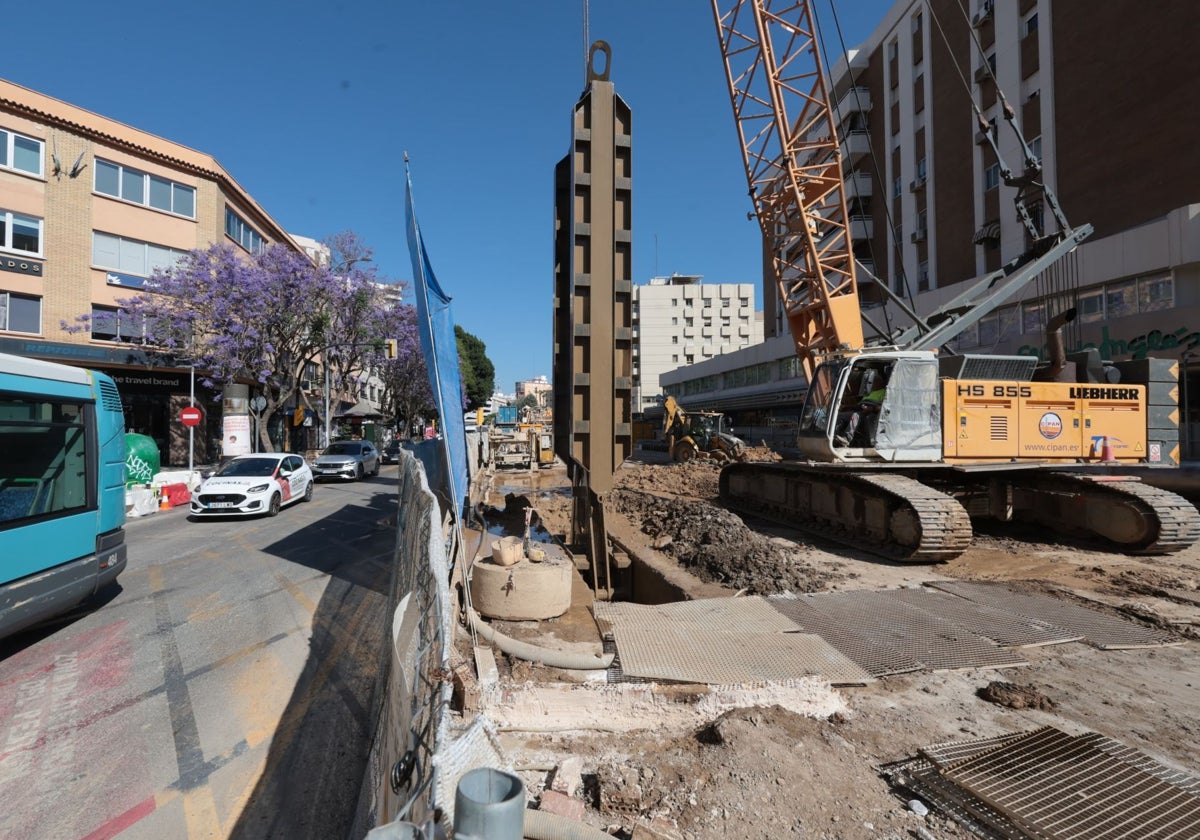Work on Malaga metro on Calle Hilera reaches halfway point and faces most complex phase
In mid-June, work will begin on the tunnel at the corner next to the Banco Santander, which means major traffic reorganisation
The metro project next to El Corte Inglés in Malaga city has reached the halfway mark. It has been under way for a year and a half now and, so far, the original 36-month deadline is maintained, meaning that work is around 50% complete.
SUR was able to verify this during a visit to the site, between Calle Armengual de la Mota and Calle Hilera, together with officials from the regional ministry of public works (Fomento) and from the construction companies in charge, Sando and Kerkros.
It is clear that preparations for the most complex phase of the work are now under way. Around 15 June, that is, in barely two weeks' time, work is scheduled to begin on the screens on the curve connecting the two tracks, which will pass very close to the corner of Banco Santander. By then, the tunnel box will already be assembled at both ends: in front of the Guadalmedina station and in front of the Escala 2000 building. In fact, the diaphragm wall machine currently working midway along Hilera will be the one moved to carry out the connection between both sides.
This crossing implies important changes. Firstly, it means major traffic reorganisation on one of the busiest routes in the city. In coordination with the city council's mobility department, vehicles will occupy the sub-section closest to El Corte Inglés where the screens have already been built. In this way, it will be possible to occupy the part between Santander and Starbucks. An important detail from an environmental point of view is that the tree - a large ceiba specimen that appears right at this point - will not have to be moved, although some of its branches will have to be pruned so as not to interfere with the machinery.
A second change concerns traffic on Hilera, which will also be transferred to the side where work is now being carried out and where the diaphragm walls will soon be completed. Therefore, traffic will go to the opposite side of the carriageway, in order for work to be carried out on the south side.
Nasrid wall?
Work technicians prefer not set a timeline, as the subsoil could pose certain challenges. Some studies have established that this is the possible location of part of the Nasrid wall that enclosed the old Attabanim suburb, as a continuation of the wall that appeared in Callejones del Perchel and which is protected as an asset of cultural interest (BIC).
Therefore, should it appear, the archaeologists will have to determine its state of conservation and the necessary actions to preserve the remains. In any case, at this point there are several old pipes and conduits, so it is likely that the wall will be very deteriorated. These question marks will set the pace in the last subsection.
To reach this point, Fomento and the construction companies have had to deal with an issue that is usually taken for granted, but which, in this case, has been more complex: the diversion of the urban services affected, with a series of specific works to make it possible to maintain electricity, water, gas and, especially, telecommunications during the works. In fact, the entire execution is designed to make high-impact infrastructure works compatible, but without excessively disrupting the day-to-day life of residents and workers in the heart of the city.
Up to 140 employees
This first section employs between 120 and 140 technicians and workers, both inside and outside the tunnel. Part of them are responsible for maintaining peaceful co-existence between the work process and residents by cleaning and organising the flow of pedestrians and vehicles, among other tasks.
The main tools used are two pantographs and an auxiliary crane, in addition to several excavators of different sizes and other tools.
Just when section 1 enters the second half of the term, next month (according to the forecast of the regional minister of Fomento, Rocío Díaz) section 2 of the tunnel on the way to the Hospital Civil and the future Hospital Regional will be launched. This is the part that will run under Eugenio Gross. The remodelling of the Las Chapas roundabout will be completed in the next few days to allow the first cuts in this busy street.
Why is it necessary to continue working into the night hours sometimes?
One of the few complaints that residents on Calle Hilera have voiced concerns the noise, especially at times when work takes longer than planned and goes into the night hours. According to technicians, once started, the screen wall has to be finished within the day - it is not possible to stop and start again the next day.
"Sometimes, there is a breakdown in a machine and the repair delays the work; or instead of being a normal screen, it is a corner in the shape of an L or a T, which are more complex, because that actually means that there are two screens. We apologise for these incidents and the noise that comes with them. We are the first to want to finish this work as soon as possible."



Comentar es una ventaja exclusiva para registrados
¿Ya eres registrado?
Inicia sesiónNecesitas ser suscriptor para poder votar.